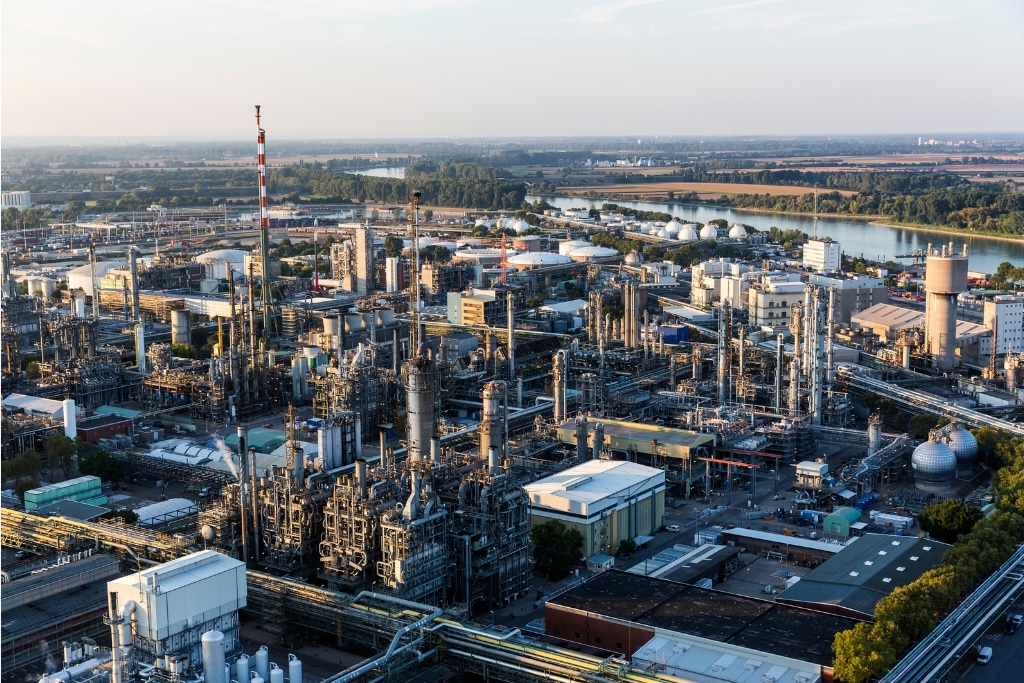To an astounding extent, running the modern world depends on a single process: petrochemical steam cracking. However, the steam cracking process emits enormous quantities of greenhouse gases. As part of a global effort to address this, a laboratory in Dalian, China, is now exploring novel options to use CO2 itself as a feedstock instead of petroleum, in a process that mimics natural photosynthesis.
—
In gargantuan manufacturing facilities around the world, hydrocarbons (normally from petroleum) are put under enormous pressure and raised to 850C in order to crack them into the basic building blocks of chemical production. These are then recombined or processed in various ways to create a vast array of products such as plastics, fertilizers, cosmetics, agrochemicals, paints, vitamins, and pharmaceutical ingredients. It is hard to overstate the importance of such basic chemicals as the source of all of the other materials that make civilization possible.
Ethylene is one of these basic building blocks. Consisting of a molecule composed of two carbon and four hydrogen atoms, it is one of the most fundamental products that result after applying heat and pressure to a hydrocarbon feedstock such as petroleum. Producing ethylene and other basic chemicals is enormously energy-intensive, emitting around 1.05kg to 1.3kg of greenhouse gas equivalents for each kilogram of ethylene manufactured in the cracker.
One way of reducing these emissions, which has already been implemented at some demonstration plants, is to power the steam cracker with renewable electricity. Another option is to use alternative feedstocks such as biological oils, an approach that is also already happening in small quantities. However, the global supply of waste cooking oil is limited, and oil-producing agricultural crops may compete with food production.
For decades, therefore, scientists have been searching for alternative ways to produce ethylene and other cracker products. One alternative could be to use carbon dioxide (CO2) – a waste product of combustion and a damaging greenhouse gas – as the feedstock. In this case, the reaction would be catalyzed not with heat and pressure but with light. Indeed, nature already produces some ethylene when sunlight drives a reaction between water (which is made of hydrogen and oxygen) and CO2. Grade school students are familiar with this process, known as photosynthesis.
Could a process similar to photosynthesis be used to synthesize the chemicals that humans consume in such enormous quantities?
To make this possible, the crucial missing element – hydrogen – must be added to the mix. This is known as hydrogenation. Fortunately, over the past several years, it has become cheaper to produce hydrogen with electrolysis, using renewable electricity.
Now, a new paper from the Dalian Institute of Chemical Physics describes a potential system for production of ethylene in a laboratory environment, using hydrogenated CO2 as the feedstock and sunlight as the catalyst.
In previous attempts to achieve a photosynthesis-like reaction, scientists had used water as their hydrogen source, just as plants do; the hydrogen is split off from the H2O directly, in order to hydrogenate the CO2. In the new method, however, scientists used hydrogen manufactured elsewhere, and bombarded a titanium dioxide catalyst with ultraviolet light – a so-called “photocatalytic” process. This allowed them to produce ethylene at room temperature, without the need for a 850C steam cracker.
Bringing this process from the laboratory to the factory is crucially dependent on the availability of cheap green hydrogen – in other words, hydrogen produced with renewable electricity.
In an emailed response to Earth.Org, Daniel Keck, Head of Technology, Basic Petrochemicals at BASF said using this pathway to produce basic chemicals “can be an interesting alternative,” although he added that only low electricity prices can guarantee competitiveness.
“This is especially true for the specific example of CO2 activation, because it requires a large amount of electrical energy. In this sense, photocatalytic materials could be an interesting alternative but still require hydrogen as a feedstock that needs to be produced by electrolysis,” he added.
The new approach presented in the paper, which was published last month, produced an extremely high yield of ethylene – more than 99%. However, the process relies on highly specific steps such as creating a type of “dipole” by situating holes on metallic gold nanoparticles with a titanium oxide layer. The process is, as such, limited to an experimental phase.
According to Keck, the method is still at a “very early stage of technology deployment.”
“This conceptual approach will need to be further developed towards efficiency and overall system cost with the target to develop a commercial technology. While the approach offers benefits, the technology hurdles for deployment are not to be underestimated and will require several years of development,” he said.
While the distance from the “lab to the fab” can be great, its potential when deployed at scale would be enormous. Global ethylene production, currently at 177 million tons per year, is projected to grow 262 million tons by 2035, with Asia accounting for more than 40%. A more sustainable path to ethylene production could impact not only this US$238 billion market but the future of our planet.
Featured image: BASF SE.
This story is funded by readers like you
Our non-profit newsroom provides climate coverage free of charge and advertising. Your one-off or monthly donations play a crucial role in supporting our operations, expanding our reach, and maintaining our editorial independence.
About EO | Mission Statement | Impact & Reach | Write for us
